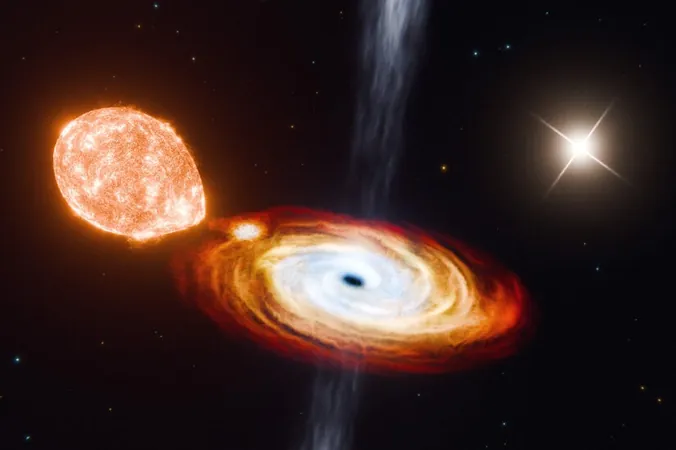
Groundbreaking ‘Black Hole Triple’ Discovery Challenges Classical Theories of Formation!
2024-12-28
Author: Sarah
Introduction
In an astounding revelation that could turn our understanding of black hole formation upside down, researchers from MIT and Caltech have unveiled a fascinating astronomical phenomenon: a “black hole triple” system. Traditionally, black holes have been observed mainly in binary pairs, where one black hole is gravitationally bound to a nearby star or another black hole. However, this unprecedented discovery not only demonstrates a black hole’s singularity but also showcases two orbiting stars, each with significantly different orbital periods.
The V404 Cygni System
Located approximately 8,000 light-years away in the Milky Way galaxy, the star system named V404 Cygni features a central black hole surrounded by two stars. One of these stars orbits the black hole with an astonishing speed, completing its cycle every 6.5 days. Conversely, the outer star takes about 70,000 years to orbit, highlighting the vast gravitational relationship at play.
Implications for Black Hole Formation
This insight is pivotal as it questions the long-held belief that black holes are birthed solely from the catastrophic explosions of dying stars, a process known as a supernova. During a supernova, the explosive force typically expels surrounding objects from orbit. Yet, the existence of the distant star in this triple system suggests that the black hole may not have formed through this violent mechanism at all.
Research Insights from Kevin Burdge
Kevin Burdge, a Pappalardo Fellow at MIT who spearheaded the research, posits that the black hole might have emerged via a gentler process known as “direct collapse.” This behavior allows surrounding celestial bodies to maintain their orbits, enabling astronomers to rethink the lifecycle of black holes. “This system is super exciting for black hole evolution, and it also raises questions of whether there are more triples out there,” Burdge stated, emphasizing the implications of this find.
Historical Context of V404 Cygni
What makes this discovery even more intriguing is the historical context. V404 Cygni, discovered in 1992, is known as one of the first recognized black holes. Despite its extensive study across more than 1,300 scientific papers, the interactions with its outer companion star had never been established until now.
Technological Advancements in Discovery
Using cutting-edge technology like Aladin Lite—a global astronomical viewing tool—Burdge noted two distinct light blobs while analyzing images of V404 Cygni. The first represented the well-documented black hole and its nearby star; the second, previously overlooked, turned out to be the distant companion star. Remarkably, this star is about 3,500 astronomical units away from the black hole, a distance equivalent to roughly 100 times the gap between Pluto and the Sun.
Confirming Gravitational Links
To ensure both stars are indeed gravitationally linked to the black hole, researchers utilized data from the Gaia satellite, which has been meticulously tracking star movements since 2014. The synchronized movements of the stars indicate a robust gravitational association, with the probability of this occurring by chance estimated at a mere one in ten million.
Understanding the System's Age
Additionally, astronomers have gathered that the outer star is entering its red giant phase, which offers insight into the system’s age—estimates place it at around 4 billion years. This remarkable understanding allows scientists to peer into the historical development of old black holes, a feat never accomplished before.
Conclusion and Future Directions
This discovery not only opens up new avenues for research into potential black hole triples but also compels scientists to reevaluate how these enigmatic entities evolve over time. Furthermore, it prompts compelling questions about how many more black holes might have originated through direct collapse rather than explosive supernovae, potentially transforming our entire comprehension of stellar phenomena.
As astronomical technology advances and researchers delve deeper into celestial mechanics, the prospects for discovering more extraordinary cosmic systems appear boundless. Prepare to keep your telescope handy; the universe just became a lot more intriguing!




 Brasil (PT)
Brasil (PT)
 Canada (EN)
Canada (EN)
 Chile (ES)
Chile (ES)
 Česko (CS)
Česko (CS)
 대한민국 (KO)
대한민국 (KO)
 España (ES)
España (ES)
 France (FR)
France (FR)
 Hong Kong (EN)
Hong Kong (EN)
 Italia (IT)
Italia (IT)
 日本 (JA)
日本 (JA)
 Magyarország (HU)
Magyarország (HU)
 Norge (NO)
Norge (NO)
 Polska (PL)
Polska (PL)
 Schweiz (DE)
Schweiz (DE)
 Singapore (EN)
Singapore (EN)
 Sverige (SV)
Sverige (SV)
 Suomi (FI)
Suomi (FI)
 Türkiye (TR)
Türkiye (TR)
 الإمارات العربية المتحدة (AR)
الإمارات العربية المتحدة (AR)